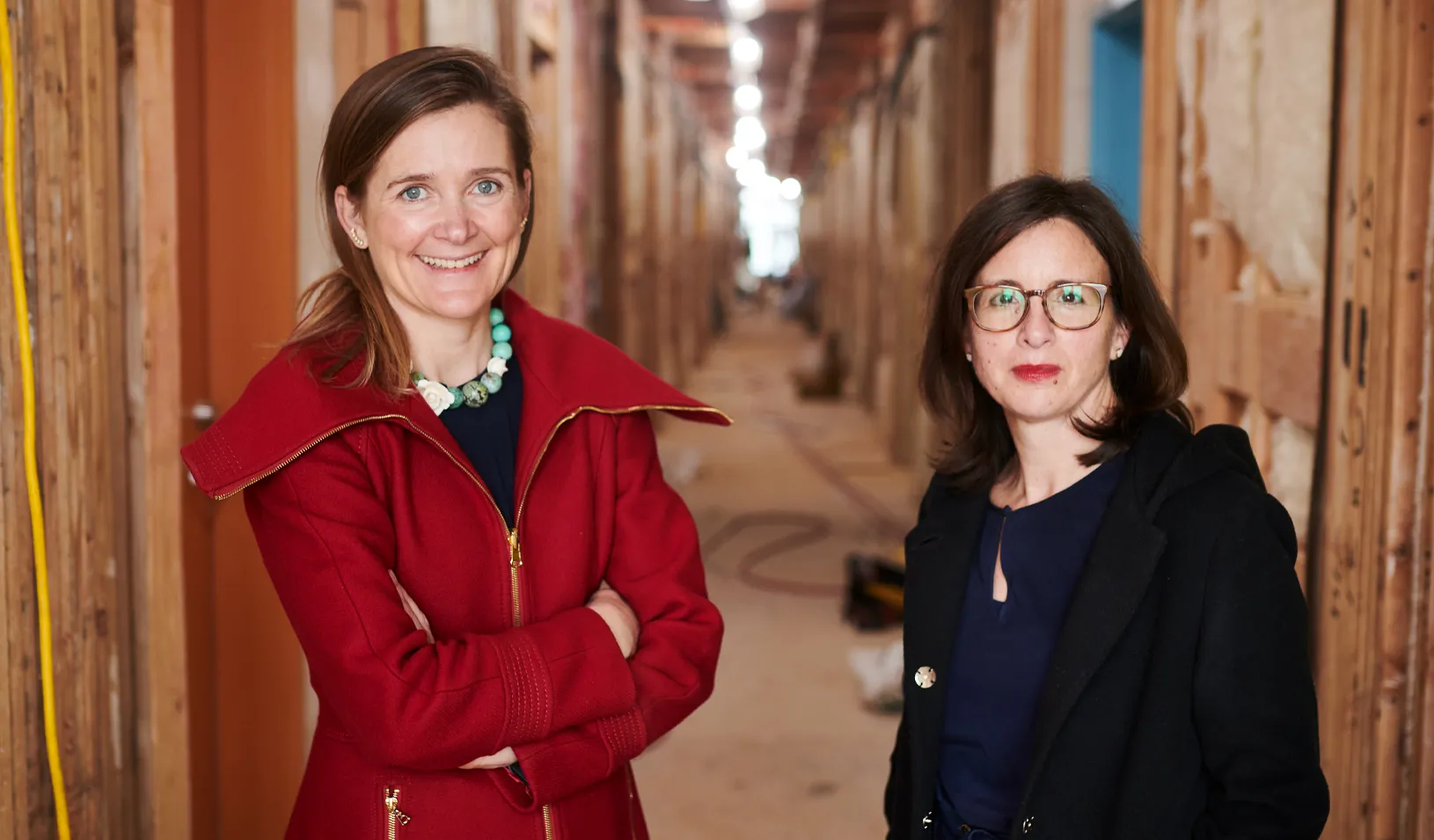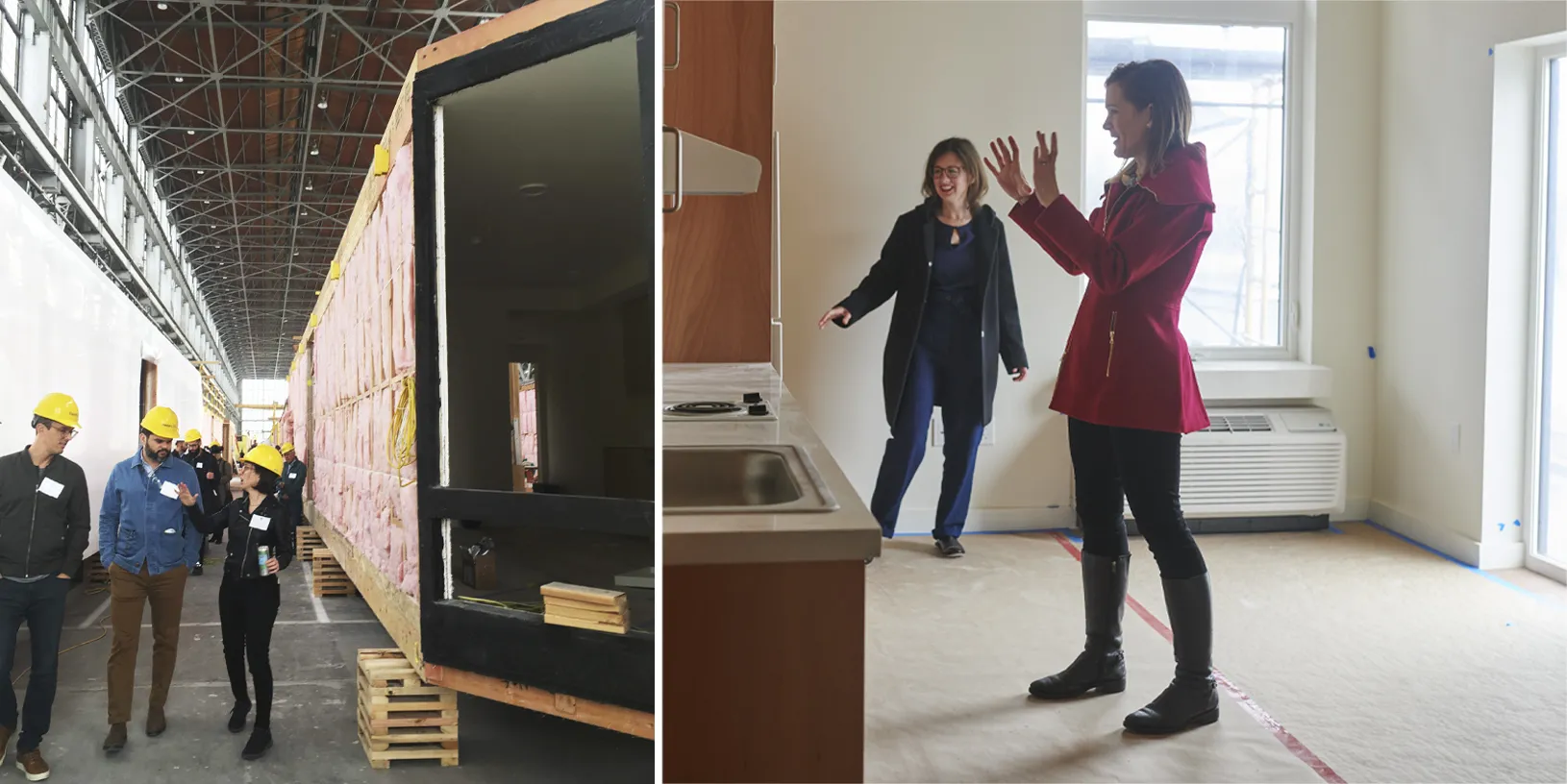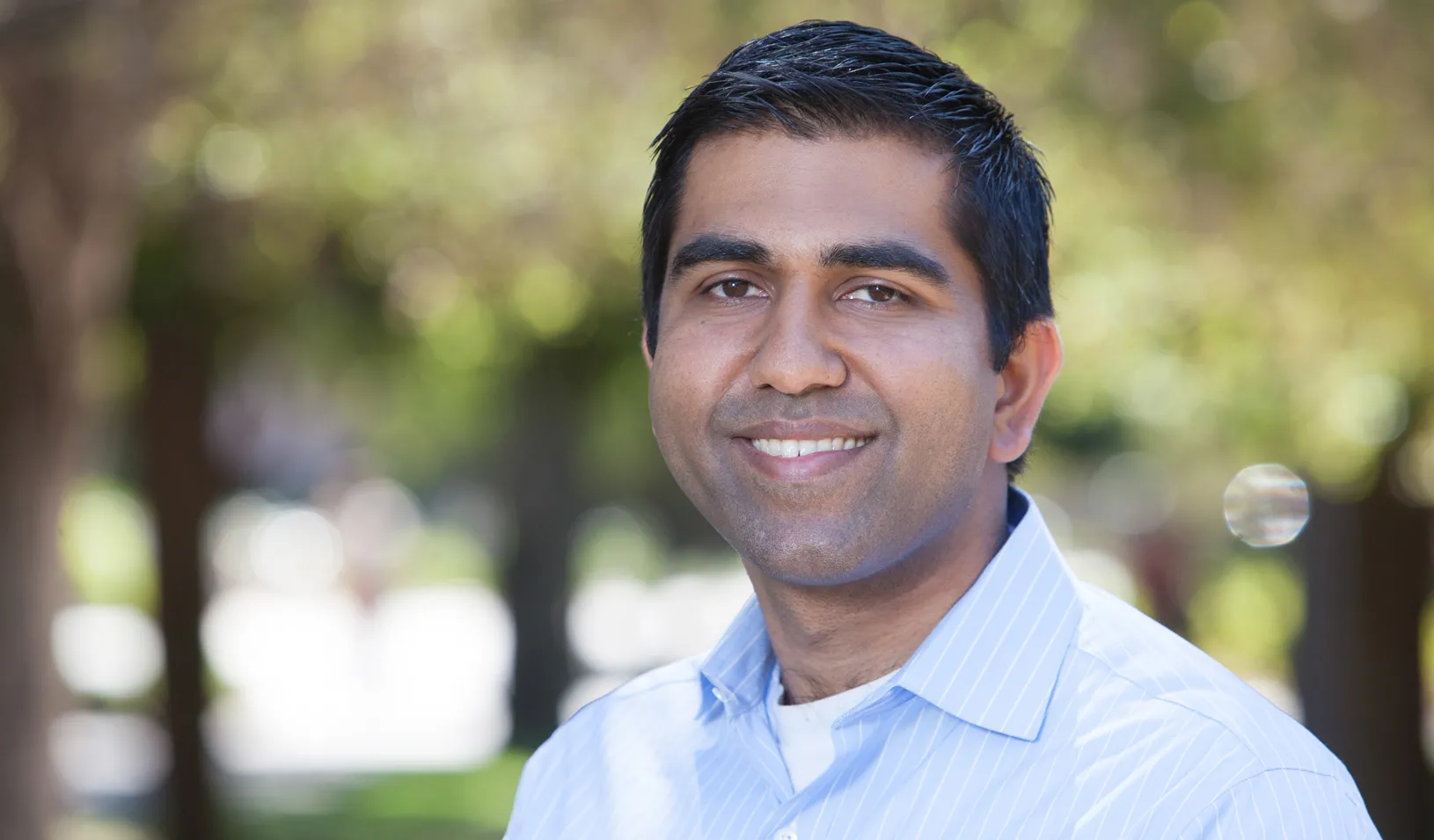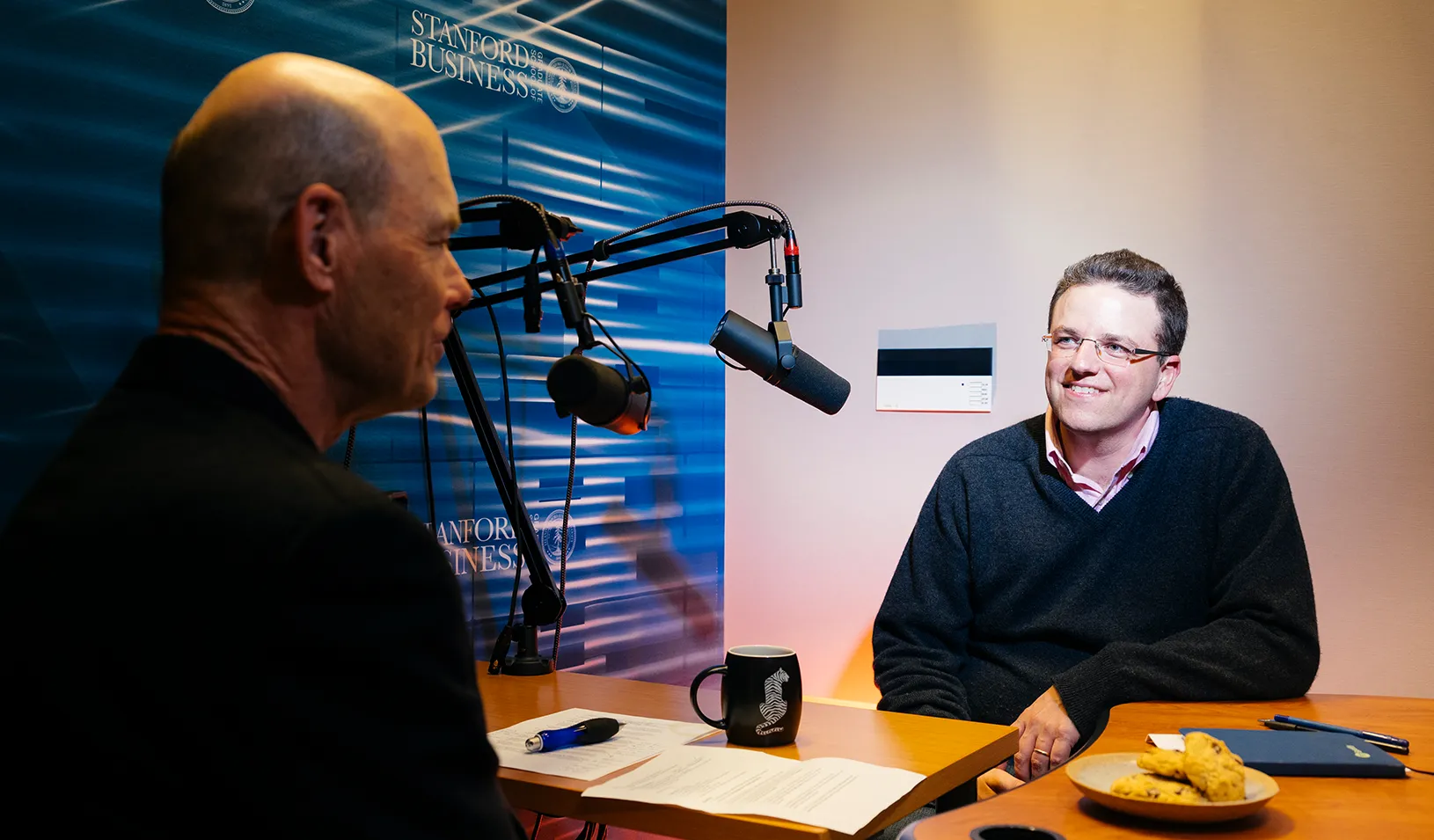Give Them Shelter
Want to solve America’s urban homeless crisis? First, you have to believe it can be fixed.
April 06, 2021

Rebecca Foster, MBA ’05 (left) and Liz Givens, MBA ’04, visit their brainchild: a six-story building in San Francisco with 145 affordable, modular homes. | Drew Kelly
Anyone who has passed by the seemingly endless rows of hard-worn tents and makeshift shelters scattered under San Francisco’s bridges, beside its freeways, and along its sidewalks has probably struggled to imagine how our nation’s homeless crisis might be solved.
The extent of the need and the human pain overwhelms, and most of us soon enough realize that our imaginations aren’t up to the task. We learn instead to avert our eyes.
Two alumni of Stanford Graduate School of Business have refused to accept that the problem is so daunting as to be hopeless. Today, Liz Givens, MBA ’04, and Rebecca Foster, MBA ’05, are watching a solution they envisioned begin to unfold: 145 clean, well-lighted new homes materializing not far from the street pandemonium that has become a part of urban life nationwide.

When it’s finished, the six-story building at 833 Bryant Street (shown here in an artist’s rendering) will be San Francisco’s first 100% affordable modular housing project. | Courtesy San Francisco Housing Accelerator Fund
In San Francisco, an estimated 8,000 men, women, and children lack a stable home at any one time. About 2,800 experience chronic, long-term homelessness. And in a city where the cost of living is vastly higher than the national average, a single unit of “supportive” housing — a safe, comfortable place to live accompanied by counseling and other services — can take up to six years to complete and cost taxpayers and/or charities upwards of $600,000.
Those metrics didn’t sit well at Tipping Point Community, where Givens works as chief development officer. The nonprofit was founded in 2005 to find new solutions to reducing poverty in the Bay Area.
“It was taking too long and costing too much to build permanently supportive housing in the city,” she says. “Our goal was to figure out how to build it fast and more cost-effectively, and we knew we weren’t going to be able to do it by ourselves. We were going to need partners.”
The organization had never created its own housing development, so Givens turned to Foster, CEO of the San Francisco Housing Accelerator Fund, a nonprofit dedicated to speeding up the delivery of permanently affordable housing. After a few conversations, Givens and Foster teamed up with Tipping Point CEO Daniel Lurie, a group of Tipping Point experts on homelessness, and other Stanford GSB alumnae, including Accelerator board member Lydia Tan, MBA ’91.
The team soon unveiled a plan that was at once laser focused and audacious: Build a permanent supportive housing project in San Francisco in less than three years at a cost of under $400,000 per unit. It would offer not just housing, but also access to the health and social services essential in helping the formerly homeless navigate their new lives.
Finding a Funder
Critically, the plan needed a philanthropic partner who shared the vision of a faster and less expensive solution to chronic homelessness. They found that in Stanford GSB alumnus Charles R. Schwab, MBA ’61, and his wife, Helen, who had donated $65 million to Tipping Point’s work, and now committed $50 million of that to the new project.
Armed with that seed capital, the team moved fast. Freed from having to cobble together different sources of funding or navigate the bureaucracy that inevitably accompanies the use of public funds, they quickly set architects working on design plans, and within six months purchased a parking lot at 833 Bryant Street, in the city’s SOMA, or South of Market Street, Pilipinas cultural district. To further cut time and cost, they opted to use prefabricated modular buildings produced at Factory_OS, a young company in Vallejo, California. Typically, builders have to wait for a construction loan to pay the heavy upfront costs required for prefabricated construction. Here, it wasn’t an issue.
“With our flexible capital, we were able to move full-steam ahead with our modular production much faster than we would have otherwise,” Foster says. “By the time we closed on our permanent financing, we were 40% done with construction.”
At Factory_OS, the units are hammered and screwed together and fitted with electrical and plumbing systems before being loaded onto trucks that lumber carefully over the Bay Bridge to the building site. There, teams lift them into place, connect the wiring and pipes, and add roofing, stairwells, and elevators.
The 260-square-foot micro-studios are small but efficient. Each has recessed lighting, one large window placed for maximum light, a living area, a private bath, and a kitchen with a two-burner stove, large refrigerator, sink, and laminate wood cupboards. To honor its neighborhood, the building is named Tahanan, a Tagalog word meaning “home,” and the perforations in its exterior metal skin display a graphic of Philippine rice terraces.
When completed at the end of this year, the six-story building will be San Francisco’s first 100% affordable modular housing project, encompassing 64,000 square feet and including 680 square feet of commercial space on the ground floor, 7,500 square feet of common amenities, and 4,400 square feet of open courtyard with landscaping and seating.
Logistical Challenges
Residents will also have access to on-site services (provided by Episcopal Community Services of San Francisco) that include case management; assistance with basic food, clothing, and transportation needs; and support in connecting to additional off-site services.
While the building’s assembly-line construction is faster and more cost-efficient than traditional methods, there have been challenges. Logistics are a headache — although the factory makes its deliveries at night, drivers must maneuver the massive and unwieldy two-unit modules over the bridge, and streets must be closed to allow crews to hoist the apartments off the truck and into place. Factory_OS employs hundreds of union carpenters, but the San Francisco Building Trades Council has raised concerns over whether modular construction poses a threat to other skilled tradespeople such as plumbers and electricians, who would perform a greater share of the labor at a traditional build.
And yet, says Givens, the project is coming together remarkably well, thanks to what team members describe as an unshakable, shared commitment to completing the project at least 30% faster and at a cost 25% to 30% below average for similar projects. That goal has required everyone on the team to take strategic risks, ranging from purchasing a parking lot site that hadn’t yet been approved for a zoning change to providing insurance company-level underwriting for Factory_OS, which was a startup with limited insurance when the project began.
“This project hasn’t always taken a straight line, but we’ve all been very clear about the goals from the very beginning, and that’s been our guiding star,” Givens says. “Everybody’s been willing to take risks, to put themselves out there and to give back to the community.”
Despite their use of philanthropic capital, the project required the long-term financial commitment of the City and County of San Francisco, Foster says. They were able to secure low-income housing tax credits and tax-exempt bonds in partnership with the State of California and Citibank, financed against a long-term lease payment and operating subsidies provided by the city. Perhaps most notably, the credits and bonds have allowed the team to pull the philanthropic capital back out of the project and rotate it into other affordable housing projects as the permanent financing sources come online.

Left: The prefabricated units are produced at Factory_OS in nearby Vallejo, California, then stacked together at the San Francisco building site. | Courtesy San Francisco Housing Accelerator Fund. Right: The microstudios are small but efficient. Each is 260 square feet and has a large window, a private bath, recessed lighting, and a built-in kitchenette. | Drew Kelly
More to Come
To date, $22 million of an estimated $42 million of those revolving funds have been reinvested into two lower Nob Hill hotels: the 232-unit Granada Hotel on Sutter Street and the 130-unit Hotel Diva on Geary Street, both of which will be refurbished to provide additional supportive housing for homeless residents. The arrangement plays to the strengths of all involved, Foster says.
“You can’t make permanently affordable housing for people with extremely low incomes without the massive funding capabilities of government, but government isn’t good at moving quickly and creatively,” she says. “Here, we were able to do what flexible capital does best — push on innovation and speed and take on all that strategic risk that’s so hard for government to do, so we could bend the time and cost curve.”
Team members hope to replicate their model — with even more speed and cost savings — in other housing projects for those experiencing homelessness. There is also the potential of improving the lives of people who aren’t homeless but still struggle to afford housing in one of the world’s most expensive cities.
The Bryant Street model, they believe, can be developed to make it possible for essential workers such as teachers and food servers — and others who are not part of the Bay Area’s lucrative tech economy — to rent pleasant apartments close to their jobs, saving them the stress of climbing over multiple sleeping roommates each morning, or making hours-long commutes in the dark from more affordable cities.
“Construction and housing is pretty entrenched in bureaucracy and ‘how it has to be,’” says Kathryn Cahill Thompson, MBA ’06, CEO of Cahill Contractors, the project’s general contractor. “This team was able to break the mold and use private funding to try something new. This is a really powerful tool that’s getting a proving ground on this 833 Bryant project. I think it’s a demonstration that’s going to be repeated in the Bay Area and around the country.”
Addressing such a fundamental problem while collaborating with classmates makes the rewards all the more fulfilling, Foster says. “Working with this team is another reminder of what an incredible part of the universe the GSB is. Part of what you get at the GSB is a confidence in your ability to create something and to solve problems, and the knowledge that you can reach out to all these resources you might have, call a professor, call a classmate. All that came back to me with this project.”
Givens agrees. “It’s been hugely fun and rewarding,” she says. “The caliber of GSB alumni doing interesting things and working in the nonprofit sector in the Bay Area was really what attracted me to the school, and I knew I’d get that entrepreneurial approach to solving some of society’s biggest challenges.
“People need hope that things can get better, and this project is a beacon of hope that solutions are possible. In these COVID times, we all can use that.”
For media inquiries, visit the Newsroom.
Explore More
Stanford GSB Professor Neil Malhotra Named Carnegie Fellow

Stanford GSB Researchers Discuss the Ideas They’re Most Excited About

Room to Grow: The Cannabis Industry Can’t Wait to Go Mainstream
